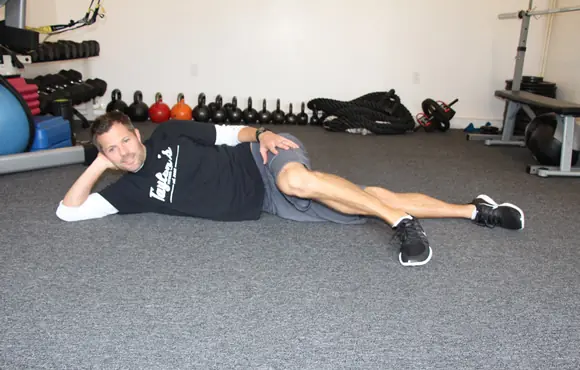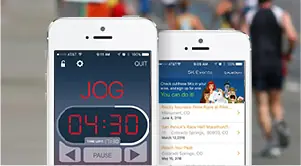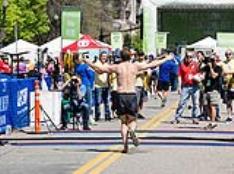In part one of the become a better runner series, we discussed how core strength prevents injury. In part two, we explored why runners should devote time to strengthening their posterior chains (hips, hamstrings and glutes). In the third and final piece of this series, we tackle the easily forgotten lower third of the body: the ankles, Achilles, calves, shins and feet.
When running, the feet are the first and last thing to touch the ground. Muscle dysfunction occurring in the lower leg can alter your running mechanics, eventually resulting in discomfort and possibly injury. Many of these issues can be avoided by simply foam rolling and strengthening these areas; find out how to keep your lower legs and feet healthy.
Feet
1 of 9
Did you know that all the muscles in your lower leg connect in the foot? The foot is the foundation of your body. If there is dysfunction in the foot, it will affect the rest of your biomechanics. If you're feeling any pain or awkwardness, you don't have to look far to figure out where the problem is coming from—the majority of the time it's coming from the lower leg: gastrocnemius, soleus and posterior tibialis.
Use a foam roller, golf or tennis ball to massage these areas to help restore proper range of motion in your feet. To strengthen your feet, complete strides barefoot after your run. If you do your strength workouts at home, don't wear shoes. You can also do toes curls by grabbing a towel with your toes and pulling it towards you.
Ankle
2 of 9
Ankle sprains are common among runners. A missed step or landing wrong can cause you to take 4 to 6 weeks off from running. You can protect yourself against this injury by doing a few simple exercises. It starts with making sure you have proper range of motion within that joint. Self-myofascial release on your lower leg will maintain or restore range of motion within the joint. Strengthen the ankle joint by completing single-leg exercises like the Bulgarian split squat, TRX lunge and single-leg deadlifts.
Complete balance exercises to increase your proprioception. Dyna disk balance exercises are great for building strength and stability in the ankle. Stand on a Dyna disk (you can even do this without any equipment; close your eyes to make the equipment-free move harder) and put the other foot behind you with the knee slightly bent.
Ankle
Dyna Disk Balance Exercise con't 3 of 9
Place an object on the floor, or simply reach for the floor, and lean forward while maintaining your balance. Complete 3 to 4 sets of 4 to 8 reps on each leg.
Achilles Tendon
4 of 9
Your Achilles is the tendon that connects the gastrocnemius and soleus to the your heel bone. Achilles tendinitis affects many runners, and is caused by overtraining, too much speed work, or increasing your mileage too quickly. Take care of your Achilles by stretching and foam rolling the calf and your soleus. Restoring these muscles will help any dysfunction in your Achilles.
How to Strengthen the Achilles
5 of 9
To strengthen the Achilles, complete eccentric exercises. Stand on a step with your right foot with your heel hanging off the back of the step. Your left leg should be slightly bent at the knee with the foot dangling behind the step (don't place your left foot on the step). Raise your right foot up, then slowly lower it back down, making sure you go below the step. Complete 3 to 5 sets of 6 to 12 reps on each leg.
Calves/Soleus
6 of 9
Tight calf and soleus muscles can cause loss of strength and stability in your feet and Achilles. Keeping these muscles unlocked can save you from nagging pain and injuries. Restore elasticity in this area by consistently targeting it with a foam roller or lacrosse ball.
To strengthen the calves, complete calf raises. Stand on a ledge with your heel hanging over the ledge. Raise your toes as high as you can and return to the starting position.
How to Stretch the Calf
7 of 9
An easy way to stretch your calf is to put your right toes against a wall while standing and keeping your right knee straight. Put your hands against the wall to help with your balance. Deepen the stretch by bending the right knee. Hold these positions for 30 to 45 seconds, and switch feet.
Shins
8 of 9
Most runners at one time or another have suffered from shin splits. Some of the causes of shin splits are over-pronation of the foot, old running shoes, muscle imbalances, and increasing your mileage too quickly. Prevent shin splits with strengthening exercises and myofascial release. To help release adhesions that build up in the soft tissue in this area, roll out your calf on both medial and lateral sides, the soleus, and the peroneus (outer lower leg) with a lacrosse ball.
To strengthen the area, sit on the floor, keeping your legs straight, and loop a towel or resistance band around the front of your extended foot. Pull your extended foot back towards your shin (dorsiflexion), then move your foot towards the floor (plantar flexion). Complete 3 sets of 15 to 30 reps.









Discuss This Article